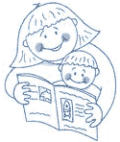|
|
Reading TogetherImagine sitting your baby in your lap and reading a book to him for the first time. How different from just talking! Now you're showing him pictures. You point to them. In a lively way, you explain what the pictures are. You've just helped you child take the next step beyond talking. You've shown him that words and pictures connect. And you've started him on his way to understanding and enjoying books. While your child is still a baby, reading aloud to him should become part of your daily routine. Pick a quiet time, such as just before you put him to bed. This will give him a chance to rest between play and sleep. If you can, read with him in your lap or snuggled next to you so that he feels close and safe. As he gets older, he may need to move around some as you read to him. Reading strategyIf he gets tired or restless, stop reading. Make reading aloud a quiet and comfortable time that your child looks forward to. Chances are very good that he will like reading all the more because of it. 
Try to spend at least 30 minutes each day reading to and with your child. At first, read for no more than a few minutes at a time, several times a day. As your child grows older, you should be able to tell if he wants you to read for longer periods. Don't be discouraged if you have to skip a day or don't always keep to your schedule. Just get back to your daily routine as soon as you can. Most of all, make sure that reading stays fun for both of you! What Does It Mean?From the earliest days, talk with your child about what you are reading. You might point to pictures and name what is in them. When he is ready, have him do the same. Ask him, for example, if he can find the little mouse in the picture, or do whatever is fun and right for the book. Later on, as you read stories, read slowly and stop now and then to think aloud about what you've read. From the time your child is able to talk, ask him such questions about the story as, "What do you think will happen next?" or "Do you know what a palace is?" Answer his questions and, if you think he doesn't understand something, stop and talk more about what he asked. Don't worry if you occasionally break the flow of a story to make clear something that is important. However, don't stop so often that the child loses track of what is happening in the story. Show Your Child That You ReadWhen you take your child to the library, check out a book for yourself. Then set a good example by letting your child see you reading for yourself. Ask your child to get one of her books and sit with you as you read your book, magazine, or newspaper. Don't worry if you feel uncomfortable with your own reading ability. It's the reading that counts. When your child sees that reading is important to you, she may decide that it is important to her, too. For ideas on how to help your child love books. (See Home for My Books >>) Look for BooksThe books that you pick to read with your child are very important. If you aren't sure of what books are right for your child, ask a librarian to help you choose titles. (For more information on what libraries have to offer. (See Visiting the Library >>) Introduce your child to books when she is a baby. Let her hold and play with books made just for babies: board books with study cardboard covers and thick pages; cloth books that are soft and washable, touch-and-feel books, or lift-the-flap books that contain surprises for your baby to discover. Choose books with covers that have big, simple pictures of things that she sees every day. Don't be upset if at first your child chews or throws a book. Be patient. Cuddling with the child as you point to and talk with great excitement about the book's pictures will soon capture her interest. When your baby becomes a toddler, she will enjoy helping to choose books for you to read to her. As your child grows into a preschooler and kindergartner, the two of you can look for books that have longer stories and more words on the pages. Also look for books that have repeating words and phrases that she can begin to read or recognize when she sees them. By early first grade, add to this mix some books designed for beginning readers, including some books that have chapters and some books that show photographs and provide true information rather than make-believe stories. Keep in mind that young children most often enjoy books about people, places, and things that are like those they know. The books can be about where you live or about parts of your culture, such as your religion, your holidays, or the way that you dress. If your child has special interests, such as dinosaurs or ballerinas, look for books about those interests. From your child's toddler years through early first grade, you also should look for books of poems and rhymes. Remember when your baby heard your talking sounds and tried to imitate them? Rhymes are an extension of that language skill. By hearing and saying rhymes, along with repeated words and phrases, your child learns about spoken sounds and about words. Rhymes also spark a child's excitement about what comes next, which adds fun and adventure to reading. For rhyming activities, (See Rhyme with Me >>)
| |||
| |
| | |